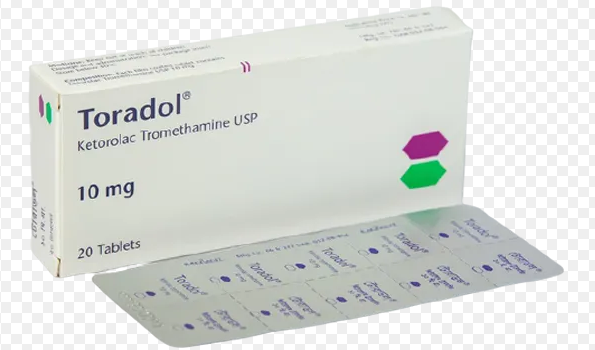Toradol (Ketorolac Tromethamine)

Toradol is the brand name for ketorolac tromethamine, a prescription-only nonsteroidal anti-inflammatory drug (NSAID) used for the short-term management of moderate to severe pain. It is not a narcotic or opioid, but its pain-relieving effects can be quite strong—comparable in some cases to low-dose morphine—without the risk of addiction.
🔹 1. Mechanism of Action
Toradol works by inhibiting cyclooxygenase (COX-1 and COX-2) enzymes, which are responsible for the production of prostaglandins—chemicals in the body that cause inflammation, pain, and fever.
By reducing prostaglandin synthesis:
- Pain and inflammation are reduced
- Fever may be lowered
- Swelling may improve
🔬 This mechanism is non-selective, meaning it blocks both COX-1 and COX-2, which can also increase the risk of gastrointestinal and kidney side effects.
🔹 2. Indications (Uses)
Toradol is typically used for short-term pain relief (≤5 days) in:
- Postoperative pain
- Acute musculoskeletal injuries (e.g., sprains)
- Renal colic (kidney stone pain)
- Acute migraine attacks (off-label)
- Moderate to severe dental pain
Note: It is not used for minor or chronic pain conditions like arthritis due to its side effect profile.
🔹 3. Available Forms and Routes of Administration
| Form | Route | Notes |
|---|---|---|
| Tablet (10 mg) | Oral | Usually taken every 4–6 hours |
| Injection (15–30 mg) | Intramuscular (IM) or Intravenous (IV) | Onset within 30 minutes; preferred in hospital settings |
| Nasal spray | Intranasal | Used in some acute care settings |
| Ophthalmic solution | Eye drops | Used for postoperative eye inflammation/pain (different formulation) |
🔹 4. Dosage Guidelines
✅ Adults (General)
- IV/IM: 15–30 mg every 6 hours, max 120 mg/day
- Oral: 10 mg every 4–6 hours, maximum duration = 5 days
- Combined use (IV → Oral): Total duration (IV + Oral) must not exceed 5 days
🚫 Not recommended in:
- Children
- Chronic pain management
🔹 5. Side Effects
Common:
- Nausea
- Dizziness
- Headache
- GI discomfort
Serious (Black Box Warnings):
- Gastrointestinal bleeding or ulcers
- Kidney toxicity
- Increased cardiovascular risk (heart attack, stroke)
- Bleeding risk (due to platelet inhibition)
🔹 6. Contraindications
Do NOT use Toradol in the following:
- Peptic ulcer disease or GI bleeding
- Recent surgery with high bleeding risk
- Renal impairment
- Concurrent NSAID use
- Before or during labor and delivery
- Allergy to NSAIDs or aspirin
- Children under 17 years old (injectable form)
- Concurrent anticoagulant therapy
🔹 7. Drug Interactions
| Drug Type | Interaction |
|---|---|
| Other NSAIDs (ibuprofen, aspirin) | ↑ Risk of GI and kidney toxicity |
| Anticoagulants (warfarin, heparin) | ↑ Bleeding risk |
| SSRIs (e.g., sertraline) | ↑ GI bleeding risk |
| ACE inhibitors/ARBs | ↑ Risk of kidney dysfunction |
| Diuretics | ↓ Diuretic efficacy, ↑ kidney stress |
| Methotrexate or lithium | Potential toxicity due to reduced clearance |
🔹 8. Advantages and Disadvantages
✅ Pros:
- Strong, non-opioid pain relief
- Available in IV/IM form, useful when oral meds aren’t possible
- Short-term use minimizes long-term risk
❌ Cons:
- Strict duration limit (≤5 days)
- Serious side effects, especially with GI, kidney, and bleeding risks
- Not suitable for chronic pain
🔹 9. Comparison: Toradol vs. Opioids
| Feature | Toradol | Opioids |
|---|---|---|
| Addiction risk | None | High |
| GI/kidney risks | High | Lower |
| Respiratory depression | None | Possible |
| Use duration | Short-term only | Can be longer (with risk) |
| Sedation | Minimal | Moderate to high |
🔹 10. Patient Education Points
- Take exactly as prescribed and not more than 5 days
- Do not mix with alcohol, NSAIDs, or aspirin
- Report signs of GI bleeding (black stools, vomiting blood)
- Stay hydrated and monitor for decreased urination
- Take oral doses with food to reduce stomach upset
🔸 Summary
Toradol (Ketorolac) is a powerful, short-term NSAID used for moderate to severe pain when opioids are to be avoided. Despite its strength, it has strict limitations due to risks of bleeding, GI ulcers, and kidney damage.
